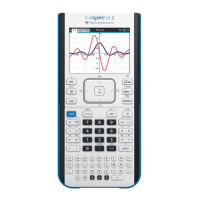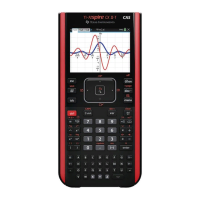92 TI-Nspire™ Reference Guide
sign()
Catalog
>
sign(Va lu e1 ) ⇒ value
sign(List1) ⇒ list
sign(Matrix1) ⇒ matrix
For real and complex Va lu e1 , returns Va l ue 1 / abs(Val ue 1) when
Va lu e1
ƒ 0.
Returns 1 if Va lu e 1 is positive.
Returns L1 if Va lu e 1 is negative.
sign(0) returns „1 if the complex format mode is Real; otherwise, it
returns itself.
sign(0) represents the unit circle in the complex domain.
For a list or matrix, returns the signs of all the elements.
If complex format mode is Real:
simult()
Catalog
>
simult(coeffMatrix, constVector[, To l]) ⇒ matrix
Returns a column vector that contains the solutions to a system of
linear equations.
Note: See also linSolve(), page 55.
coeffMatrix must be a square matrix that contains the coefficients of
the equations.
constVector must have the same number of rows (same dimension)
as coeffMatrix and contain the constants.
Optionally, any matrix element is treated as zero if its absolute value
is less than Tol . This tolerance is used only if the matrix has floating-
point entries and does not contain any symbolic variables that have
not been assigned a value. Otherwise, Tol is ignored.
• If you set the Auto or Approximate mode to Approximate,
computations are done using floating-point arithmetic.
•If Tol is omitted or not used, the default tolerance is calculated
as:
5EL14 ·max(dim(coeffMatrix)) ·rowNorm(coeffMatrix)
Solve for x and y:
x + 2y = 1
3x + 4y = L1
The solution is x=L3 and y=2.
Solve:
ax + by = 1
cx + dy = 2
simult(coeffMatrix, constMatrix[, Tol ]) ⇒ matrix
Solves multiple systems of linear equations, where each system has
the same equation coefficients but different constants.
Each column in constMatrix must contain the constants for a system
of equations. Each column in the resulting matrix contains the
solution for the corresponding system.
Solve:
x + 2y = 1
3x + 4y = L1
x + 2y = 2
3x + 4y = L3
For the first system, x=L3 and y=2. For the second system, x=L7
and y=9/2.

